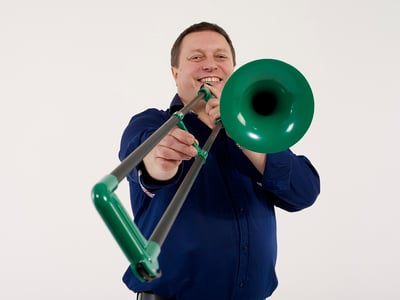Search for topics or resources
Enter your search below and hit enter or click the search icon.
April 24th, 2024
1 min read

Hey there, aspiring trombonists, brass teachers, and supportive parents! Holding a trombone correctly might not sound like rocket science, but it’s crucial for playing comfortably and effectively.
In this article, we'll look at some insider tips from education expert Chris Fower. If you've just picked up a pBone for the first time, this is the place to start! This guide was originally created to help educators who are teaching beginners, but the tips from Chris are perfect for parents or beginners teaching themselves to play the trombone!
We'll break down the simple yet vital steps to perfect trombone posture, focusing on how to bring the mouthpiece to your lips just right.

1. Establish Your Hand Positions
- Left-Hand Position: The left-hand holds the instrument. Aim for a relaxed grip with a straight wrist to form a stable base—a "pyramid of support".
- Right-Hand Position: Your right-hand controls the slide. Ensure a correct and comfortable grasp. This setup is important for smooth slide movement later on.
2. Aligning the Mouthpiece
- Angle of Attack: You’ve already learned the optimal angle for your mouthpiece during buzzing exercises. Now, it’s time to replicate this with the instrument.
- Bringing the Instrument to You: Keep your head up and look straight ahead. The mouthpiece should come to your lips, not the other way around. This prevents strain and encourages better posture.
3. The Importance of Posture
- Head and Shoulders: Maintain an upright head position and straight gaze. This aligns your airways and improves sound production.
- Arm Relaxation: Keep your arms relaxed, not raised too high or clamped too tightly. Comfort is key to maintaining posture without fatigue.
4. Recapping the Core Principles
- Creating Support: Your hands and arms create a supporting pyramid that stabilises the trombone without excessive force.
- Ease and Simplicity: While trombone posture requires more attention than some other instruments, the goal is to keep it straightforward and stress-free.
5. Practice Makes Perfect
- Consistency: Regular practice of these posture techniques will make them second nature.
- Checking Alignment: Use a mirror to check your posture from the side and ensure everything lines up as taught.
Mastering how to hold a trombone correctly might take a bit of practice, but it’s well worth the effort. By following these steps, young musicians will not only feel more comfortable but also play better and with more confidence. Remember, good posture leads to great performance!
Adam is the Content Manager at pBone Music. This should mean that he’s the ideal person to write about himself, but he finds boasting in the third person a little awkward. He honed his word wizardry with a degree in English Language and Literature at the University of Leeds. He has since written copy for clients and businesses across the land, from awards to something beginning with “z”. He also spent a number of years as a musician. He has written pop songs and even jingles for kids, performed more first dances at weddings than you could shake a pBuzz at, and once played a gig for a pie company at The Etihad Stadium in Manchester. When he’s not reminiscing about those good old days, you might find Adam enjoying the football (although as an Everton fan, that can be difficult). He also loves spending time with his partner, Jen, and his family and friends, and sincerely hopes they feel the same way.
Topics: